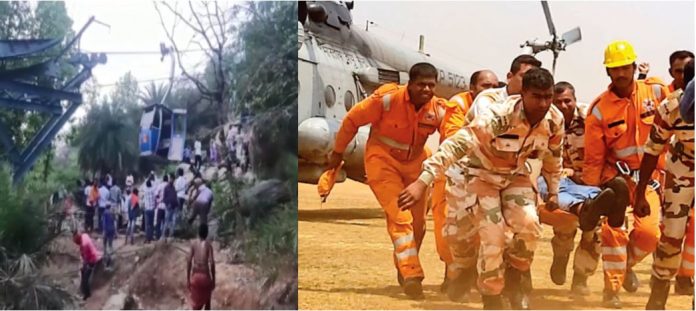After the ropeway accident in Jharkhand’s Trikut Hills which left three people dead and led to a terrifying ordeal for almost 60 tourists in the swaying cars which collided due to a technical snag, the centre has woken up to the dangers concerning ropeway operations in India. The Union Home Secretary, Ajay Bhalla, in a letter to chief secretaries of all states said that the Jharkhand incident highlights the need to have a detailed Standard Operating Procedure (SOP) and a contingency plan on ropeway operations in India to prevent the occurrence of any such incident in the future.
The Jharkhand High Court has taken suo motu cognizance of the ropeway accident. The Court has also issued orders for investigation in this matter. The matter will come up for hearing on April 26. Before this, the state government will have to present a detailed investigation report to the Court. There have been earlier incidents of ropeway accidents in India, but the latest on the ropeway in Trikut Hills in District Deoghar, Jharkhand, was one of the worst in terms of deaths and number of tourists involved in the horrific incident.
Jharkhand Tourism Department director Rahul Sinha said that on April 10, the axle of the ropeway had come off, due to which the ropeway had stopped in the middle. Hundreds of tourists had arrived on Ram Navami for worshipping and sightseeing. A trolley of the ropeway which was descending collided with the trolley going up. Due to three trolleys of the ropeway being displayed and colliding with each other, the trolleys above also started shaking. Because of this, they also collided with the boulders due to which the accident happened. There were 18 trolleys carrying about 59 passengers. Despite valiant efforts made by Indian Air Force, NDRF, Indian Army, ITBP, and the local administration, the stranded persons were eventually rescued, but three precious lives were lost. One person fell off a helicopter when she was being winched up, taking the death toll in the incident to three. Deoghar Civil Surgeon CK Shahi said the woman, identified as 60-year-old Shobha Devi, was declared dead on being taken to a hospital. Fourteen of the tourists trapped mid-air for around 40 hours were rescued by Indian Air Force helicopters, bringing an end to the operations.
Bhalla said that for operation and maintenance of ropeway projects, BIS Standards have already been prescribed, which need to be scrupulously adhered to. The necessary guidance can be taken from the National Highways and Infrastructure Development Corporation (NHIDCL), which is the nodal organisation under the Ministry of Road, Transport, and Highways, Government of India.
“The State government must engage an experienced and qualified firm or organization for carrying out safety audits of each ropeway project. The entity operating the ropeway must comply with all the issues arising out of the audit. For each ropeway project, a maintenance manual must be prepared. In addition to the maintenance manual, there should be a maintenance programme so that the safety standards conform to good industry practices. The entity operating the ropeways must maintain a record of all the activities undertaken as part of the maintenance programme,” the letter said.
The home secretary further said that all ropeway projects in states must ensure that SOPS, contingency plans for operation and maintenance of ropeways and a system of safety audits are in place. It should also be ensured that mock drills/mock exercises for handling contingency situations involving ropeways are periodically conducted.
A technical team, formed in 2009, had raised questions on the ropeway project. The team found in the investigation that there was a steep climb on the upper part, where the vibration in the cable cars increased. This makes the trolley imbalanced. The tension of the ropeway also becomes more than normal at the maximum altitude of a radius of 800 metres. After going up, the trolley started vibrating, but all these were apparently ignored.
Ropeway tragedies in India
Chhattisgarh: A labourer died after a ropeway trolley he was travelling in crashed into a tower in Dongargarh area of Rajnandgaon district in February 2021. News reports said that the trolley got unbalanced while on the ropeway, resulting in it crashing into a tower.
Gulmarg: In June 2017, a tree uprooted due to strong winds, fell on the ropeway carrying the trolley and snapped it. The cable car carrying the victims plummeted to the ground from a great height. Four members of a family and three other guides lost their lives, while another 150 people were stranded due to the incident. The then Jammu and Kashmir government ordered a high-level inquiry into the accident and a look into why the cable cars were being operated during strong winds.
Visakhapatnam: Seven tourists were injured in February 2016 after a cable car they were travelling in down the Kailasagiri Hill Park snapped from the hook and fell down. The cable car wasn’t very high up so the incident was not fatal.
Timber Trail: This went down in history for being one of the most daring rescue operations ever seen. In October 1992, around 11 passengers had boarded the famous cable car from Timber Trail to Timber Heights in the Shivalik Hills in Himachal Pradesh’s Parwanoo area. They were about to dock when the cable car’s haulage cable broke and the car started sliding backwards. Thanks to the courage and valour displayed by Indian Air Force helicopter personnel and a para commando, the 10 people were rescued and brought home safely.
—By Adarsh Kumar and India Legal Bureau


